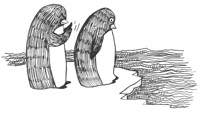STRANGE BUT TRUE- Penguin push: How the killer whale gets his meal

DRAWING BY DEBORAH DERR McCLINTOCK
Q. What strategy do penguins use to avoid being attacked and devoured by a killer whale?–Shamu
A. They "play a waiting game akin to killer-whale roulette," says Mark Buchanan in The Social Atom. By a form of social cooperation or learning, groups of penguins keep a careful watch on each other, taking note when another penguin ventures into the infested water to see how it fares. At first, only the hungriest penguin ventures in, until the coast is proven clear or to be avoided at all costs.
Yet at times no penguin gets that desperate, and so all hang back, waiting. In such cases, it has been known for some penguins to toss a sacrificial one into the drink "with a not-so-gentle nudge." The general social category here is "imitation"– or doing what others in the group have done safely or not doing what hasn't worked. This of course is a far-reaching favorite of humans as well.
Q. When you drive, do you really make as good time as you think you do? Or asked another way, what's your "average automotive speed"?–S.Racer
A. Let's assume you drive about 12,000 miles a year. To do that, you have to spend about $6,000 per year on payments, repairs, gasoline, insurance and all the rest. So to run your car you've got to work an average of about two months out of 12, or about 8 weeks, or about 300 hours a year. That's finances.
Then there's the actual time you spend in your car, which if you're typical is about one hour a day to drive your 12,000 miles. This computes to an additional 300 or so hours a year spent on transporting yourself. And let's not forget time for washings and polishings, tire and oil checks, repairs and what-not. We'll conservatively toss in another hour a week, or 50 more hours a year sunk into your automobility. Now, totaling the number of hours spent on both getting places and maintaining your wheels, we get 300 + 300 + 50 = 650 hours.
And considering that these 650 hours are invested to travel 12,000 miles, and that your average speed equals the overall distance divided by your time spent in getting there, then we need to divide 12,000 miles by 650 hours.
What this computation yields is the surprising figure of an average of 18.5 miles traveled per hour of time you spend on or in your car. Yes, that's 18.5 mph! (Based on "Guesstimation," by Lawrence Weinstein and John A. Adam)
Q. What's the origin of political "mud-slinging"?–V. Goode
A. It dates back to ancient Rome when candidates for the senate wore white togas, inviting mudballs from detractors, says "Isaac Asimov's Book of Facts." The toga of an unpopular figure soon became "toga maculosa" (defiled by mud), meaning he could no longer be a candidate– literally, "clothed in white."
~
Send strange questions to brothers Bill and Rich at [email protected].
#